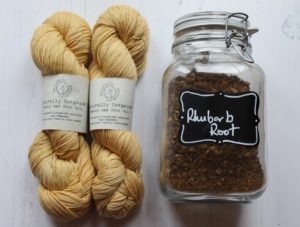
Caroline Bawn of Gorgeous Yarns explains how she creates natural dyes from plants…
Throughout history, since weaving textiles became common, people have used natural dyes to create colourful garments. In Medieval times people would not have worn the dull browns we might think, but a range of subtle green, brown, yellows and oranges, all from foraged plants, berries, leaves and bark. The most rare, difficult to obtain and process colours, like purple for Royalty, were reserved for the wealthy and reflected the wearer’s status.
The process for dyeing onto animal fibres is different to dyeing on plant fibres, and trial and error would have taught what worked best, often with stale and pungent urine as a fixative – fortunately we can now use mineral salt fixatives for our natural dyes! Most natural dyes need this fixative or “mordant” (from the Old French, Morder, to grip) as this helps the dye colour literally grip the fibre and remain fairly colourfast. Some dyes have their own “built in “ mordant, especially barks and tree dye stuffs like Oak Galls and Acorns.
Natural dyes, of course have no harsh petro-chemicals in them and so are ideal if you are dyeing fabric or fibre to make something for someone with sensitive skin. Its also a positive choice to reduce your carbon footprint, enjoy Nature’s bounty and create something special unique. The colour palette natural dyes give you are generally soft and subtle, and surprising colours go well together, for example mustard yellow of Rhubarb root (Rheum Rhabarbarum) and rich rust of Madder roots. (Rubia Tinctorum). Interestingly, lots of plants which have been used for centuries to dye with have tinctorum as part of their Latin name.

Each season, the garden and hedgerows give us a foraging and harvesting opportunity, and many will continue to give colour throughout the season. Early stinging nettle leaves give a pale greenish yellow, but as the summer comes and goes, the colour darkens, and by the autumn, the colour is more of a khaki. In fact, the first khaki uniforms were wool dyed with stinging nettles for the First World War. (So many uniforms needed, and not enough red dye which was traditionally used for British uniforms.)
Spring gives us gorse flowers, bracken fronds, daffodils, and young comfrey leaves. A favourite of mine is Dyer’s Chamomile (Cota tinctoria) which gives a reliable and stable yellow and can be overdyed to give other shades, such a lime-green with weak copper solution.
Summer gives us a riot of colour from flowers in the garden, hedgerow horse parsley, (Smyrnium olastratum) hawthorn berries, (Crataegus monogyna) rose hips (Rosa canina) and elderberries (Sambucus nigra) to name a few.
The gentle colour changes in nature around us in autumn are reflected in the gentler dye shades you can obtain. Alder cones, (Alnus glutinosa) acorns and oak galls, (Quercus robur) Willow (Salix alba) and copper beech (Fagus sylvatica purpurea) all give beautiful tones of honey, beige, brown and grey.When foraging natural dye plants, follow the common sense rules: Only pick what you need, and no more; Don’t strip one plant of dye stuff, spread your foraging,
Get any permission from the land owner to harvest what you need; Be very sure of what you are harvesting, and if necessary wear protective gloves and use secateurs; Don’t put yourself at risk by climbing up trees or foraging on main roads. If in doubt, don’t pick. (That’s why I never use fungi to dye with, I’m not sure what I’m picking and don’t want to poison myself!)

How to make natural dye
Collect the dye stuffs when they are dry, so that no mould will develop and either use them immediately, or dye then for later use. Generally, you will need 200% dye plant to fabric/fibre weight if using fresh, and 100% if using dry dye stuff. The mordant you use with your dye stuff will depend on what fabric/fibre you are using.
Once the fabric/fibre has been mordanted, the colour is “extracted” from the dye stuff, often by gently heating to make an infusion. Some dyestuffs, like acorns, oak galls and alder cones are better crushed; madder, nettles and rhubarb roots need to be chopped, and some flowers like daffodils need to be pulled away from the calyx before infusion. They all need to be strained as all those bits in your wool fibre is a nightmare!
Once you have the dye liquid, you are ready to go. Only use a pan which will not be used to cook in again. Dyes are pH reactive, so stainless steel is best, aluminium can change the colour you expect. Even the pH of your water will make a difference, especially if you use spring or rain water.
Dye your fibre gently, particularly wool which can shrink and felt in the pan, and once you are happy with the intensity of colour and/or it is not getting darker, remove your fabric/fibre, leave to cool, then wash in cool water until no further colour comes out. Dye gently in the air, out of the sun. Hand dyed yarns and fabrics like this will not have an even, solid colour – that’s normal and part of their beauty.
Gorgeous Yarns will be in the Artisan Barn at Toby’s Garden Festival on 3rd and 4th May

